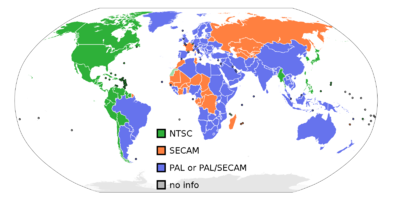PAL
Within the video game community, PAL is a term used to refer to the region of Europe, Asia (minus Japan), Africa, most of South America, and Australia. The term comes from the analog television encoding system Phase Alternate Line, the primary method of encoding analog TV for these parts of the world.
PAL is most commonly used as shorthand for "the European version of a game". Historically, Europe is usually the third and final region for games made in Japan to be released, as games have to be translated into several languages, a process that takes both more time and more space than the NTSC region. In addition, due to cultural differences, the English translation cannot always be simply copied from the American version of the game. As a result, PAL releases are often the final version of the game, with all known bugs fixed and possibly significant changes added.
Summary of PAL releases of the Super Smash Bros. series
Super Smash Bros.
The original Super Smash Bros.'s PAL release is not notably different than its NTSC version, retaining all its changes while very slightly buffing or nerfing a few characters.
Super Smash Bros. Melee
The PAL version of Melee began with the 1.2 version from NTSC, but then added balancing changes to several characters, resulting in dramatic metagame differences between the two regions. For example, Falco's down aerial can no longer spike opponents during the late hit, and so is harder to use effectively. Fox, Sheik, and Marth have also been nerfed in notable ways.
It should be noted that many of the PAL version's attributes - such as Falco's down aerial and the semi-spike being removed from the entirety of Link's Spin Attack - remain unchanged in Brawl. As a result, it appears that the developers used the PAL version of Melee as the base when developing Brawl.
Super Smash Bros. Brawl
In order for cross-region online play to be possible, the only differences between versions of Brawl are purely aesthetic, though they are still encoded differently. In particular, Masterpieces are slightly different in the PAL version, running at 50 hertz as opposed to the NTSC version's 60 hertz.
Super Smash Bros. 4 / Super Smash Bros. Ultimate
Neither version of Smash 4, nor Ultimate, use analog connections; as such, the gameplay is identical in both the PAL and NTSC versions of these games, again accommodating for cross-region multiplayer. However, the PAL version of Smash 4 uses a variety of different names for characters, moves, and items, most notably Duck Hunt Duo, Mii Sword Fighters, Housewarming Party, Duck Jump Duo, and (in both SSB4 and Ultimate) the Football. In addition, both Wii Fit Trainers have different voices in the PAL versions, and completely different translations for incidental text such as trophy descriptions. Masterpieces, however, are now identical to the NTSC version, running at 60 hertz.

